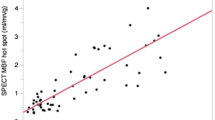Abstract
Measuring absolute myocardial blood flow (MBF) is becoming a common aid for diagnosing patients suspected to have coronary artery disease. An MBF study, however, requires a scanner with high count rate capability, is more susceptible to artifacts, and is much more technically involved than static imaging, which leads to a greater risk of artifactual results contaminating the final result. This technical note gives the reader an introductory understanding of the method for calculating MBF. It then describes the scanning protocol, potential pitfalls and how to recognize them, and quality control steps that should be taken to avoid basing a clinical decision on possibly inaccurate flow information.






Similar content being viewed by others
Abbreviations
- MBF:
-
Myocardial blood flow
- BGO:
-
Bismuth germanate
- LSO:
-
Lutetium oxyorthosilicate
- LYSO:
-
Lutetium-yttrium oxyorthosilicate
- GSO:
-
Gadolinium oxyorthosilicate
- ROI:
-
Region of interest
- TAC(s):
-
Time activity curve(s)
- QC:
-
Quality control
References
Schindler TH, Schelbert H. Cardiac PET imaging for the detection and monitoring of coronary artery disease and microvascular health. JACC Cardiovasc Imaging. 2010;3(6):623–40.
Maddahi J, Packard RR. Cardiac PET perfusion tracers: Current status and future directions. Semin Nucl Med. 2014;44(5):333–43.
Moody JB, Lee BC. Precision and accuracy of clinical quantification of myocardial blood flow by dynamic PET: A technical perspective. J Nucl Cardiol. 2015;22(5):935–51.
Cerqueira MD, Weissman NJ. Standardized myocardial segmentation and nomenclature for tomographic imaging of the heart. A statement for healthcare professionals from the Cardiac Imaging Committee of the Council on Clinical Cardiology of the American Heart Association. Circulation. 2002;105(4):539–42.
Friedman J, Van Train K. Upward creep of the heart: A frequent source of false-positive reversible defects during thallium-201 stress-redistribution SPECT. J Nucl Med. 1989;30(10):18–22.
Disclosure
John R. Votaw has received consulting fees from Syntermed, Inc. René R. Sevag Packard reports no potential conflicts of interest.
Author information
Authors and Affiliations
Corresponding author
Rights and permissions
About this article
Cite this article
Votaw, J.R., Packard, R.R.S. Technical aspects of acquiring and measuring myocardial blood flow: Method, technique, and QA. J. Nucl. Cardiol. 25, 665–670 (2018). https://doi.org/10.1007/s12350-017-1049-y
Received:
Accepted:
Published:
Issue Date:
DOI: https://doi.org/10.1007/s12350-017-1049-y




